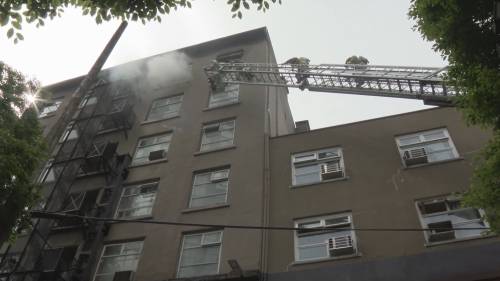As smoke billowed from the windows of the Granville Street single-room occupancy (SRO) hotel last Thursday, Vancouver firefighters faced a grim but increasingly familiar scenario. The predawn blaze forced dozens of vulnerable residents into the streets, highlighting the precarious living conditions that persist in many of the city’s aging low-income buildings.
“We arrived to find heavy smoke on the third floor with several residents hanging out windows,” said Battalion Chief Mike Sereda, who coordinated the emergency response. “Our primary concern was evacuation while containing the fire to a single unit.”
The fire, which officials believe started in a kitchenette area around 3:15 a.m., damaged four rooms and left at least 12 people temporarily homeless. While investigators haven’t determined the exact cause, the incident has reignited concerns about safety standards in Vancouver’s approximately 157 SRO buildings, which house roughly 7,000 residents.
For Marcia Thompson, a housing advocate with the Downtown Eastside SRO Collaborative, these fires represent systemic problems rather than isolated incidents. “These buildings often lack proper electrical systems, have outdated fire suppression equipment, and residents sometimes resort to unsafe heating methods,” she told me during a walk through the Granville corridor the day after the fire.
Vancouver Fire Rescue Services reported responding to over 40 significant incidents at SRO buildings in 2023 alone, a 15% increase from the previous year. Many of these aging structures date back to the early 1900s, built long before modern fire codes existed.
Mayor Ken Sim addressed the situation during a press conference Friday, acknowledging the challenges while outlining plans to improve conditions. “We’re fast-tracking safety inspections across all SROs and have allocated $3.5 million for emergency repairs in city-owned buildings,” Sim stated. “This incident demonstrates why our housing strategy must prioritize both creating new housing and upgrading existing stock.”
The provincial government has purchased several SRO buildings in recent years, including 10 properties acquired for $115 million in 2021. Despite these investments, upgrades have been slow to materialize for many residents.
Harold Jenkins, who has lived in a nearby SRO for five years, watched the fire response from across the street. “We’ve been telling them about faulty wiring and overloaded circuits for years,” he said, pointing to extension cords visible in several windows. “Most of us have hot plates or space heaters because the building systems don’t work properly.”
What makes these fires particularly concerning is the vulnerable population they affect. SROs typically house individuals on fixed incomes, many with health challenges or disabilities that make emergency evacuation especially difficult.
BC Housing data shows approximately 40% of SRO residents are over 55, while an estimated 30% live with mobility issues. During Thursday’s fire, firefighters had to carry several residents down from upper floors when smoke filled hallways, cutting off escape routes.
The aging infrastructure creates a perfect storm of risk factors. A 2022 engineering assessment commissioned by the city found that 65% of privately-owned SROs had significant deficiencies in their electrical systems, while 48% had compromised fire separation between units.
“We’re dealing with buildings that were already outdated half a century ago,” explained urban planner Janet Morrison from the University of British Columbia. “The economics of low-income housing creates perverse incentives where basic maintenance gets deferred until systems fail catastrophically.”
Beyond the immediate danger fires pose, displacement carries its own risks. Red Cross workers set up a temporary shelter at nearby Gathering Place Community Centre, but longer-term accommodation remains uncertain for those whose rooms suffered the worst damage.
“When people lose their SRO rooms, they often end up homeless,” said street nurse Catherine Matthews, who assists residents with health needs. “We’re seeing this cycle where people are displaced from unsafe housing only to face even more dangerous conditions on the street.”
City councillor Jean Swanson, who has long advocated for SRO residents, pushed for stronger enforcement measures at Tuesday’s council meeting. “We need to use every tool available – from conducting more frequent inspections to applying meaningful penalties when landlords fail to maintain these buildings,” she argued.
The Vancouver Fire Code grants inspectors authority to order immediate repairs when life-threatening conditions are identified, but staffing limitations mean most buildings receive comprehensive inspections only once every two years.
Fire Chief Karen Fry has requested additional resources to increase inspection frequency. “Our prevention team is stretched thin,” she acknowledged. “With more inspectors, we could identify problems before they lead to emergencies.”
For residents of Vancouver’s SROs, each fire alarm brings fresh anxiety. Mei Lin, who lives down the hall from where Thursday’s fire started, described the chaos. “The smoke was so thick I couldn’t see the exit signs. I just followed voices until I reached the stairwell.”
As cleanup continues at the Granville Street building, questions persist about how to prevent the next emergency. The city’s recently announced $50 million SRO revitalization fund may help, but experts say addressing decades of neglect requires sustained investment and political will.
The most effective solution – replacing these aging buildings with modern, safe, affordable housing – remains the most challenging to implement in a city with sky-high construction costs and limited available land.
For now, residents like Harold Jenkins continue living with uncertainty. “Every night when I plug in my hot plate, I wonder if this is the night something goes wrong,” he said. “But what choice do we have? It’s this or the street.”






